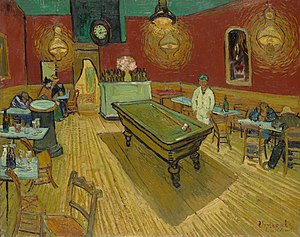A few weeks ago Anita and I went to the Yale Art Gallery. I’ve
known about it for a long time but had never been. One painting in particular I
wanted to see was Vincent Van Gogh’s “Night Café.” This famous painting has
been in New Haven for about fifty years.
He painted it to settle his debt with the
café owner, who was also his landlord.
The painting depicts an all-night café in Arles, France,
where Van Gogh was living at the time. He described the café in letters to his
brother: “Night
prowlers” can take refuge there when they have no money to pay for a lodging,
or are too drunk to be taken in.” He later described his goal in making the
painting: "In
my picture of the Night Café I have tried to express the idea that the
café is a place where one can ruin oneself, go mad or commit a crime.”
A
place of desperation, perhaps?
Van
Gogh was a deeply spiritual person, to use contemporary terminology, but he
rejected organized Christianity as an institutionalized faith that did not
address the basic needs of people. He attempted to prepare for the ministry,
spending several years working among the poor in both England and his native Holland.
His mentors felt he spent too much time among the poor. He gave up his hopes of
being a pastor and floundered for awhile before discovering art. His early
paintings are dark, and depict the poor as they live their lives in
desperation. Several years into his brief, ten year art career he discovered
color, and the style that he is known for was born. Van Gogh struggled with
depression and anxiety during his adult life, and committed suicide in 1890 at
the age of 37.
 |
| Vincent Van Gogh, Night Cafe, Yale University Art Gallery |
Van
Gogh’s paintings, for the most part, are not religious, but many have a
theological or spiritual meaning. Many of his paintings portray the beauty of
creation. His portraits celebrate the uniqueness of individuals. His earlier
paintings, although not nearly as well-known as his later works, depict the grinding
pain of poverty. That is also a theological concept.
People
often ask where God is amidst suffering. It is natural to feel abandoned by God
in the midst of suffering. Although not an easy answer, one response is that
God is present in suffering. That isn’t to be trite. God is present with us in
the midst of our suffering, present in the person of Jesus. In Christ, God is
present in the suffering of the poor. And, God is present in the hands of those
who offer hope to the poor. Van Gogh understood this, and unfortunately the
world did not understand. I wonder if the world ever
will understand.
Jenny and I went to the Van Gogh museum in Amsterdam. Really rather bizarre to be in a room with a dozen iconic paintings of sunflowers - and Irises - all together.
ReplyDelete